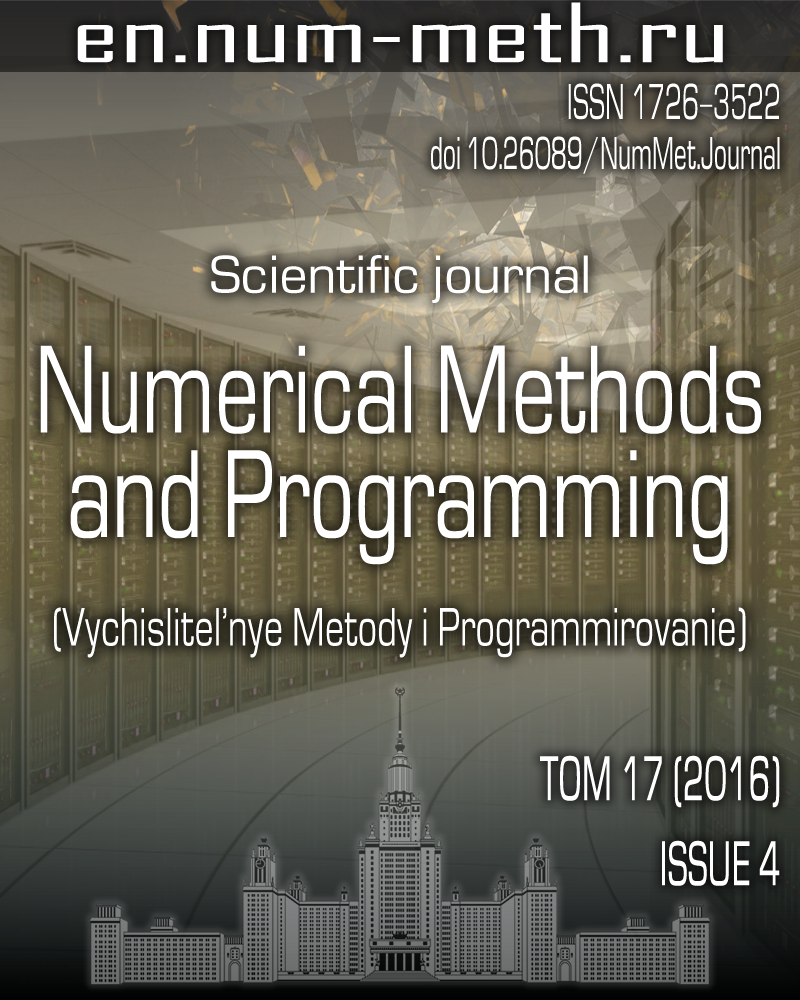DOI: https://doi.org/10.26089/NumMet.v17r439
Frequency dependence simulation of electromagnetic characteristics for saturated porous media
Keywords:
Abstract
A method to perform numerical simulations of effective spectral electromagnetic characteristics for porous media saturated with multicomponent fluid is proposed. This method is applied to numerical models of porous media whose fluid component distribution is determined by the direct hydrodynamic simulation using the density functional method. The numerical results obtained for the effective electrical conductivity and relative dielectric permittivity of porous media with various water saturation values and rock wettability are discussed. The results obtained with consideration of the frequency dependence of one of the fluid components and without considering such a dependence are compared. The effect of the relation between the electrical characteristics of components in the model on the effective parameters is analyzed.
Published
Issue
Section
References
- G. E. Archie, “The Electrical Resistivity Log as an Aid in Determining Some Reservoir Characteristics,” Trans. Amer. Inst. Min. Metall. Eng. 146, 54-62 (1942).
- R. Knight and A. Abad, “Rock/Water Interaction in Dielectric Properties: Experiments with Hydrophobic Sandstones,” Geophysics 60 (2), 431-436 (1995).
- N. Bona, E. Rossi, C. Venturini, et al., “Characterization of Rock Wettability through Dielectric Measurements,” Oil Gas Sci. Technol. 53 (6), 771-783 (1998).
- D. L. Johnson, J. Koplik, and L. M. Schwartz, “New Pore-Size Parameter Characterizing Transport in Porous Media,” Phys. Rev. Lett. 57 (20), 2564-2567 (1986).
- Q. Niu and A. Revil, “Connecting Complex Conductivity Spectra to Mercury Porosimetry of Sedimentary Rocks,” Geophysics 81 (1), E17-E32 (2016).
- P. Debye, Polar Molecules (Dover, New York, 1945).
- K. S. Cole and R. H. Cole, “Dispersion and Absorption in Dielectrics I. Alternating Current Characteristics,” J. Chem. Phys. 9 (4), 341-351 (1941).
- A. Sihvola, “Mixing Rules with Complex Dielectric Coefficients,” Subsur. Sensing Technol. Appl. 1 (4), 393-415 (2000).
- K. Asami, “Dielectric Dispersion in Biological Cells of Complex Geometry Simulated by the Three-Dimensional Finite Difference Method,” J. Phys. D: Appl. Phys. 39 (3), 492-499 (2006).
- M. Luo and H. Pan, “A Numerical Study on the Relation between the Electrical Spectra of a Mixture and the Electrical Properties of the Components of the Mixture,” J. Appl. Geophys. 112, 33-41 (2015).
- E. Toumelin, C. Torres-Verdin, and N. Bona, “Improving Petrophysical Interpretation with Wide-Band Electromagnetic Measurements,” SPE J. 13 (2), 205-215 (2008).
- F. Mees, R. Swennen, M. van Geet, and P. Jacobs, “Applications of X-Ray Computed Tomography in the Geosciences,” in Applications of X-Ray Computed Tomography in the Geosciences (Geological Society, London, 2003), Vol. 215, pp. 1-6.
- A. Yu. Dem’yanov, O. Yu. Dinariev, and N. V. Evseev, Foundations of the Density Functional Method in Hydrodynamics (Fizmatlit, Moscow, 2009) [in Russian].
- N. A. Semenov, Theoretical Electrodynamics (Svyaz’, Moscow, 1973) [in Russian].
- E. J. Rothwell and M. J. Cloud, Electromagnetics (CRC Press, Boca Raton, 2008).
- V. V. Nikol’skii, The Electromagnetic Field Theory (Vysshaya Shkola, Moscow, 1961) [in Russian].
- G. L. G. Sleijpen and D. R. Fokkema, “BICGSTAB(L) for Linear Equations Involving Unsymmetric Matrices with Complex Spectrum,” Electron. Trans. Numer. Anal. 1, 11-32 (1993).
- {PETS}c User’s Manual.
http://www.mcs.anl.gov/petsc . Cited November 1, 2016. - K. Nörtemann, J. Hilland, and U. Kaatze, “Dielectric Properties of Aqueous NaCl Solutions at Microwave Frequencies,” J. Phys. Chem. A 101 (37), 6864-6869 (1997).
- M. Köhler, P. Lunkenheimer, and A. Loidl, “Dielectric and Conductivity Relaxation in Mixtures of Glycerol with LiCl,” Eur. Phys. J. E 27 (2), 115-122 (2008).
- N. S. Midi, K. Sasaki, R. Ohyama, and N. Shinyashiki, “Broadband Complex Dielectric Constants of Water and Sodium Chloride Aqueous Solutions with Different DC Conductivities,” IEEJ Trans. Electr. Electr. Eng. 9 (S1), S8-S12 (2014).
- A. Weller, K. Breede, L. Slater, and S. Nordsiek, “Effect of Changing Water Salinity on Complex Conductivity Spectra of Sandstones,” Geophysics 76 (5), F315-F327 (2011).
- A. Revil and M. Skold, “Salinity Dependence of Spectral Induced Polarization in Sands and Sandstones,” Geophys. J. Int. 187 (2), 813-824 (2011).
- A. Yu. Demianov, O. Yu. Dinariev, and D. A. Lisitsin, “Numerical Simulation of Electromagnetic Properties of the Saturated Rock Media with Surface Conductivity Effects,” Komp’yut. Issled. Model. 7 (5), 1081-1088 (2015).
- X. Zhan, L. M. Sсhwartz, M. N. Torksöz, et al., “Pore-Scale Modeling of Electrical and Fluid Transport in Berea Sandstone,” Geophysics 75 (5), F135-F142 (2010).

